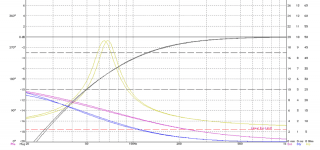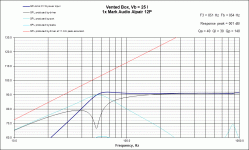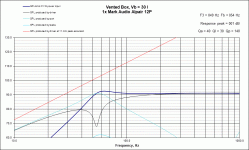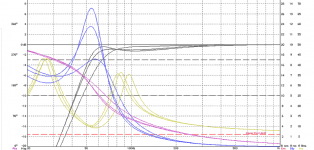The Simple Reflex 16L Alpair 12p Standmount looks very interesting and I might just go with it.
I have read on DIY that the optimal size for the Alpair 12p is 16-20L. Has anybody built the 20L? Is there is big difference with the 16L?
I also saw on Lautsprechershop.de a 30 L version. Would this be a better standmount?
The Pensil is not a standmount but a 52 L floorstander that gets a lot of praise. So is there really an "optimal" size box? So what if you put the 12p in a 40 L box will that work? I guess a lot is trial and error.
The Pensil is not a bass reflex but a variation of an MLTL, for which the physics work different. Transmission line loudspeaker - Wikipedia (basic descirption) and Quarter Wavelength Loudspeaker Design (the math and physics behind it) for more info about this.
For a bass reflex, the size will be more or less 16-20L, a TL type of alignment will be much bigger, but it has other advantages. I prefer TL's above bass reflex, at least when the size is not an issue.
The Pensil is not a standmount but a 52 L floorstander
It is a 83 litre ML-TL.
So what if you put the 12p in a 40 L box will that work?
It won’t work in a BR that large. Too small to be a decent horn, so you want a compact ML-TL.
I have a 49 litre one one the books. A smaller custom one might be possible.
dave
I think I covered most of these points when they were originally asked about a week ago, but I'll go through them again, just to reinforce what I said at the time & others have also noted:
'Optimal' is a floating point that varies with requirements. The above is what I would call a reasonable volume & tuning alignment for a conventional vented box using this driver, assuming a voltage source amplifier and about 1/2ohm series R for typical wire, connection resistance.
You say 'the 20L'. Which?
Pass, without knowing what box you are referring to.
That's a quarter-wave design; tuning is not purely a function of the internal volume but the geometry of the enclosure.
Two points there. First, it's a floorstander, and has to be a floorstander because it's a quarter-wave variation and the geometry of the enclosure is a functional part of the alignment. You can't just take the internal volume & change the box dimensions. Secondly, define 'better'.
Only when you define your goals.
You asked that a week ago, and I'll give you the answer I did then: only if you add about 5 1/2ohms of series resistance with a voltage source amplifier, or alternative have an amplifier with roughly equivalent output impedance. It will have a very poor alignment otherwise.
No, this is well-proven physics.
The Simple Reflex 16L Alpair 12p Standmount looks very interesting and I might just go with it.
I have read on DIY that the optimal size for the Alpair 12p is 16-20L.
'Optimal' is a floating point that varies with requirements. The above is what I would call a reasonable volume & tuning alignment for a conventional vented box using this driver, assuming a voltage source amplifier and about 1/2ohm series R for typical wire, connection resistance.
Has anybody built the 20L?
You say 'the 20L'. Which?
Is there is big difference with the 16L?
Pass, without knowing what box you are referring to.
I also saw on Lautsprechershop.de a 30 L version.
That's a quarter-wave design; tuning is not purely a function of the internal volume but the geometry of the enclosure.
Would this be a better standmount?
Two points there. First, it's a floorstander, and has to be a floorstander because it's a quarter-wave variation and the geometry of the enclosure is a functional part of the alignment. You can't just take the internal volume & change the box dimensions. Secondly, define 'better'.
The Pensil is not a standmount but a 52 L floorstander that gets a lot of praise. So is there really an "optimal" size box?
Only when you define your goals.
So what if you put the 12p in a 40 L box will that work?
You asked that a week ago, and I'll give you the answer I did then: only if you add about 5 1/2ohms of series resistance with a voltage source amplifier, or alternative have an amplifier with roughly equivalent output impedance. It will have a very poor alignment otherwise.
I guess a lot is trial and error.
No, this is well-proven physics.
Scott,
Going out on a limb here - would a folded Pensil 12 work as a (large) standmount?
The port will not longer be coupled with the floor, and am not sure if that will have an effect on the LF output.
Going out on a limb here - would a folded Pensil 12 work as a (large) standmount?
The port will not longer be coupled with the floor, and am not sure if that will have an effect on the LF output.
That can certainly be done for pipes with a relatively small CSA relative to the length, which are fairly easy to fold up. With the kind of length & CSA of the Pensil 12P, it would be difficult / almost impossible to maintain the longitudinal eigenmode if you tried folding it as the internal divider wouldn't be long enough, and a literal impossibility with the Super Pensil 12P.
Last edited:
\Dave:It is a 83 litre ML-TLThe Pensil is not a standmount but a 52 L floorstander
I should have mentioned that I was referring to the Small Pensil 12.2p.
Yep.
I got confused since the description says it's a bass reflex
Unfortunately there are many ML-TLs out there where the designer thinks he has done a BR but after measuring them have had to adjust/lower the tuning frequency.
Yes!!! That is exactly what I am looking for. A 35-45L speaker enclosure that is about 25-30cm X 30-35cm X 50-60cm.
We are only talking 3 litre savings. The box as drawn is 270x1078x254
dave
Last edited:
With the kind of length & CSA of the Pensil 12P, it would be difficult / almost impossible to maintain the longitudinal eigenmode
Having folded many of Scott’s ML-TL. As the size of the fold becomes more nebulous (when a box is squarish, or depth greater than width. To make a folded Pensil one woold forst have to change the aspect ratio of the cross-section so that the box is wide and shallow. Then the bottom of the line can be folded back and up to create the fold.
You will no long have a pensil, but it should have somewhat similar performance in the bass.
dave
"Yes!!! That is exactly what I am looking for. A 35-45L speaker enclosure that is about 25-30cm X 30-35cm X 50-60cm"
We are only talking 3 litre savings. The box as drawn is 270x1078x254
Dave
Yes I understand that it is only a 3 litre difference but the dimension I stated would give me placement options. If I move the speakers to another room, which I intent on doing, all I would need to do is adjust the stands to bring them at ear height. At a height of 1078mm that would make it harder to adjust. And they might even be higher than my present listening position. Can I get you to make a custom box using the my dimensions?
We are only talking 3 litre savings. The box as drawn is 270x1078x254
Dave
Yes I understand that it is only a 3 litre difference but the dimension I stated would give me placement options. If I move the speakers to another room, which I intent on doing, all I would need to do is adjust the stands to bring them at ear height. At a height of 1078mm that would make it harder to adjust. And they might even be higher than my present listening position. Can I get you to make a custom box using the my dimensions?
I would need some help in deciding which one of these 2 enclosures give the best measurement for the Alpair 12p.Can someone please run these numbers through some measurement software and let me know which one to build? Obviously, I am open to minor dimension alterations.
I tried playing with WinISD but for some reason I could not save the driver's T/S parameters.
Box 1) internal measurements= 24cm X 39cm X 27cm
Box 2) internal measurements= 24cm X 39cm X 32cm
I very much appreciate your help.
I tried playing with WinISD but for some reason I could not save the driver's T/S parameters.
Box 1) internal measurements= 24cm X 39cm X 27cm
Box 2) internal measurements= 24cm X 39cm X 32cm
I very much appreciate your help.
How do you define 'best', and what tuning frequency[ies]?
I'm currently on my laptop so can't look closely at this precise moment in history, but assuming a voltage source amp both look significantly over-sized for the 12P assuming a regular vented box, so will either have a large peak at tuning if tuned relatively high (unless heavily damped), or some form of quasi EBS alignment if tuned relatively low, so may lack LF output unless either boundary-loaded, or used with a high output impedance amplifier / equivalent series resistance.
I'm currently on my laptop so can't look closely at this precise moment in history, but assuming a voltage source amp both look significantly over-sized for the 12P assuming a regular vented box, so will either have a large peak at tuning if tuned relatively high (unless heavily damped), or some form of quasi EBS alignment if tuned relatively low, so may lack LF output unless either boundary-loaded, or used with a high output impedance amplifier / equivalent series resistance.
I forget to mention that the port size for Box 1 is 80mm X 148mm tuned at 54Hz and Box 2 is 80mm X 114mm tuned at 54Hz.
My amp is a 6 watt EL84 SEP with an output impedance close to 1 ohm. The speakers will be back vented and placed close to boundaries.
My amp is a 6 watt EL84 SEP with an output impedance close to 1 ohm. The speakers will be back vented and placed close to boundaries.
...and as far as vented is concerned, as predicted (and several of us have pointed out previously) those sorts of volumes are somewhat over-sized for the 12P short of a relatively high output impedance amplifier, with underdamped (peaking) alignments at tuning under anechoic conditions (attached, assuming 1ohm output impedance). With a rear vent and near-boundary positioning, you are likely to experience more significant gain peaking at tuning, and potentially a 'one note' / 'on-off' effect due to that and the relatively narrow vent tuning, unless the boxes are heavily damped. Power handling may also suffer somewhat, and you may encounter some self-resonant effects (standing waves) in the duct due to the length / CSA ratio, although the rear position should mean this latter is unlikely to be a significant problem.
Generally speaking, I've seen worse, but they're not what I'd call particularly good alignments.
Generally speaking, I've seen worse, but they're not what I'd call particularly good alignments.
Attachments
Now armed with the tuning frequency.
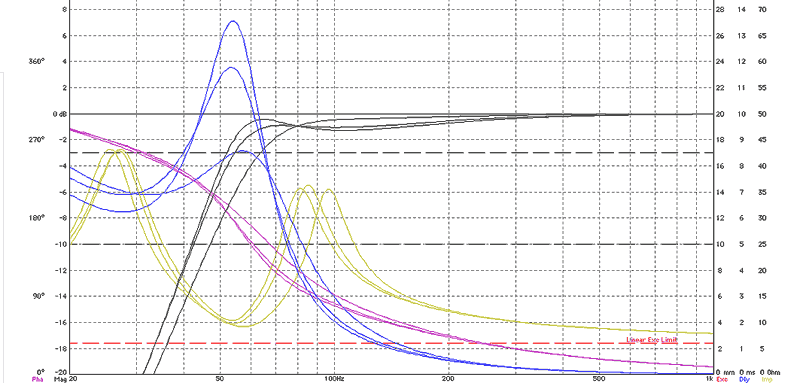
You can see the bump Scott talks about.
My first rule of vented boxes is that the 1[su[]st[/sup] derivative of th eFR curve shoud not cross zero more than once.
You can see your 2 (poor) alignments along with one in 17 litres that is decent (not the one i use in the Mar-Kens, i have to account for another facet of my designs.
dave
You can see the bump Scott talks about.
My first rule of vented boxes is that the 1[su[]st[/sup] derivative of th eFR curve shoud not cross zero more than once.
You can see your 2 (poor) alignments along with one in 17 litres that is decent (not the one i use in the Mar-Kens, i have to account for another facet of my designs.
dave
Attachments
Two minds, with but a single thought. 😉
Those are very close indeed; what minor differences there are are purely the different damping coefficients & slight alterations for the amplifier output impedance.
Those are very close indeed; what minor differences there are are purely the different damping coefficients & slight alterations for the amplifier output impedance.
The amp is a Finale and Frank assured me it was 6 watts and I have no reasons to doubt him.
With modern tube amps, experience has taught me to take a caveat emptor stance WRT published specs same as with driver/speaker specs, so if lacking sufficient fancy test gear, use your speakers, ears and voltmeter connected to the speaker terminals to figure your 'useful' highest distortion max volts/power to select new components/speakers, then power = volts^2/speaker nominal ohms rating will be good enough regardless of what Frank or fancy test equipment 'says'. 😉
Absolutely. 😉
As a 'for interest' aside, one thing I have noted: the current fad for high Qm / low RMS / (insert preferred definition here) does not appear to have done production consistency many favours in quite a few cases I could mention. Over the last couple of years, many of the units I've measured targeting low mechanical damping have exhibited greater deviation from spec. & between samples than others which haven't prioritised this quite so heavily. YMMV as ever of course.
As a 'for interest' aside, one thing I have noted: the current fad for high Qm / low RMS / (insert preferred definition here) does not appear to have done production consistency many favours in quite a few cases I could mention. Over the last couple of years, many of the units I've measured targeting low mechanical damping have exhibited greater deviation from spec. & between samples than others which haven't prioritised this quite so heavily. YMMV as ever of course.
- Home
- Loudspeakers
- Full Range
- Help needed for 2nd DIY project
